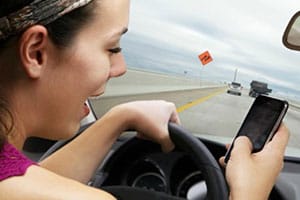
Teenagers who text when they drive are likelier to be involved in other, dangerous activities, a new study reveals. Risky behaviors included riding with an intoxicated driver or not wearing a seatbelt, according to Reuters Health, The researchers, from the U.S. Centers for Disease Control and Prevention (CDC) found that four in every nine high […]
 Teenagers who text when they drive are likelier to be involved in other, dangerous activities, a new study reveals.
Teenagers who text when they drive are likelier to be involved in other, dangerous activities, a new study reveals.
Risky behaviors included riding with an intoxicated driver or not wearing a seatbelt, according to Reuters Health, The researchers, from the U.S. Centers for Disease Control and Prevention (CDC) found that four in every nine high school students had either sent or received texts while driving in the past month alone.
“Considering it’s against the law for teens to be texting while driving in 45 states, it’s a little concerning,” Emily Olsen, a health statistician in the CDC’s Division of Adolescent and School Health and the report’s lead author, told Reuters Health.
As we’ve written, studies have found that safe texting when driving is not possible. Also, a 2011, national, anonymous survey, conducted by the CDC previously revealed that 58 percent of the high school senior students and 43 percent of the high school juniors surveyed admitted to having had texted or emailed on their devices while driving in the previous month, according to the Associated Press (AP).
Other previous research has suggested that teen texting when driving was common, but did not reveal that the practice was as high as it is, said the AP. Prior studies presented at the Pediatric Academic Societies in Boston, Massachusetts also found that the mere thought of texting on a mobile device while driving might be enough to cause teens to crash. In fact, studies have suggested that teenage drivers who text with their device in any position and teens who just think about texting, are likelier to crash.
This study revealed that prior, single-state studies found that anywhere from one-quarter to nearly three-quarters of teens text while driving, according to Reuters Health.
The team reviewed responses to the CDC’s annual youth risk survey to obtain an understanding of the problem from a national perspective. On the 2011 survey, conducted in public and private schools nationwide, 8,505 high school students ages 16 and older were asked about potentially dangerous driving behaviors in which they had been involved in the prior month. Nearly 45 percent said they had engaged in texting while driving at least once and nearly 12 percent said they texted while driving daily.
Past research has revealed that texting while driving can lessen reaction times and worsen a driver’s ability to remain in one lane when driving. In fact, the more often students reported that they texted when driving, the likelier they were to also say they had engaged in other, dangerous behaviors, according to the Reuters Health report.
“It’s concerning that kids are participating in these multiple behaviors, either while they’re driving or while they’re a passenger,” Olsen told Reuters Health. “Each one of these things is quite dangerous (on its own).”
“That just really highlighted that as far as prevention goes, we really need something comprehensive,” Jessica Mirman, who has studied teen motor vehicle cell phone use at Children’s Hospital of Philadelphia’s Center for Injury Research and Prevention, who was not involved in the new research, told Reuters Health. “It’s not just about texting. It’s not just about drinking.”


